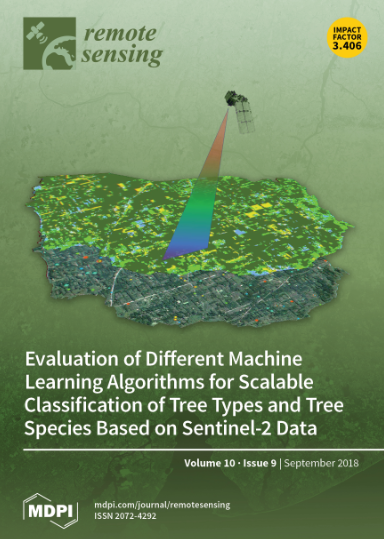利用无人机和哨兵-2 图像量化祁连冰川表面的污浊程度
IF 4.2
2区 地球科学
Q2 ENVIRONMENTAL SCIENCES
引用次数: 0
摘要
冰川表面不仅由冰或雪构成,还由各种材料的异质混合物构成。吸光杂质的存在会使冰川表面变暗,降低局部反射率,从而加速冰川融化过程。然而,我们对这些杂质空间分布的了解仍然有限,也缺乏对冰川表面脏污程度的量化研究。在2023年8月21日 "哨兵 "卫星飞越青藏高原期间,我们使用ASD FieldSpec3光谱仪测量了青藏高原七一冰川不同脏污程度冰川表面的反射光谱。利用多端成员光谱混合分析法(MESMA),对哨兵图像进行分解,生成以下五种主要冰面材料的分量图像:粗粒雪、轻微脏冰、中度脏冰、极度脏冰和碎屑。利用分辨率为 0.05 米的无人飞行器 (UAV) 图像,对主冰面进行了划定,并将其作为验证碎屑图像的参考数据。研究结果表明,馏分图像与参考数据之间具有很强的相关性(R2 ≥ 0.66,RMSE ≤ 0.21)。根据无人机图像的像素分类,约 80% 的冰川表面被轻度脏冰(19.2%)、中度脏冰(33.3%)、极度脏冰(26.3%)和碎屑(1.2%)覆盖,这在很大程度上导致了冰川变暗。我们的研究表明,将哨兵成像与 MESMA 结合使用,可有效准确地测绘冰川表面的脏污程度。本文章由计算机程序翻译,如有差异,请以英文原文为准。
Quantifying Qiyi Glacier Surface Dirtiness Using UAV and Sentinel-2 Imagery
The glacier surface is composed not only of ice or snow but also of a heterogeneous mixture of various materials. The presence of light-absorbing impurities darkens the glacier surface, reducing local reflectance and thereby accelerating the glacier melting process. However, our understanding of the spatial distribution of these impurities remains limited, and there is a lack of studies on quantifying the dirty degree of glacier surfaces. During the Sentinel satellite overpass on 21 August 2023, we used an ASD FieldSpec3 spectrometer to measure the reflectance spectra of glacier surfaces with varying degrees of dirtiness on the Qiyi glacier, Qinghai–Tibet Plateau. Using Multiple Endmember Spectral Mixture Analysis (MESMA), the Sentinel imagery was decomposed to generate fraction images of five primary ice surface materials as follows: coarse-grained snow, slightly dirty ice, moderately dirty ice, extremely dirty ice, and debris. Using unmanned aerial vehicle (UAV) imagery with a 0.05 m resolution, the primary ice surface was delineated and utilized as reference data to validate the fraction images. The findings revealed a strong correlation between the fraction images and the reference data (R2 ≥ 0.66, RMSE ≤ 0.21). Based on pixel-based classification from the UAV imagery, approximately 80% of the glacier surface is covered by slightly dirty ice (19.2%), moderately dirty ice (33.3%), extremely dirty ice (26.3%), and debris (1.2%), which significantly contributes to its darkening. Our study demonstrates the effectiveness of using Sentinel imagery in conjunction with MESMA to map the degree of glacier surface dirtiness accurately.
求助全文
通过发布文献求助,成功后即可免费获取论文全文。
去求助
来源期刊

Remote Sensing
REMOTE SENSING-
CiteScore
8.30
自引率
24.00%
发文量
5435
审稿时长
20.66 days
期刊介绍:
Remote Sensing (ISSN 2072-4292) publishes regular research papers, reviews, letters and communications covering all aspects of the remote sensing process, from instrument design and signal processing to the retrieval of geophysical parameters and their application in geosciences. Our aim is to encourage scientists to publish experimental, theoretical and computational results in as much detail as possible so that results can be easily reproduced. There is no restriction on the length of the papers. The full experimental details must be provided so that the results can be reproduced.
 求助内容:
求助内容: 应助结果提醒方式:
应助结果提醒方式:


